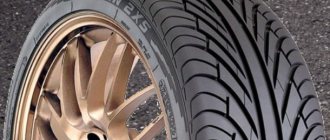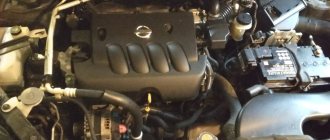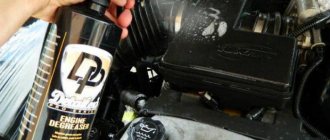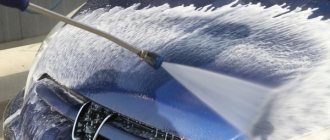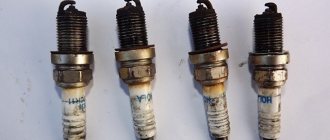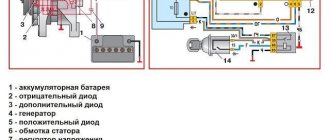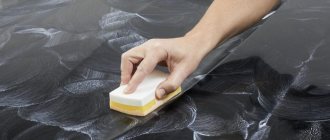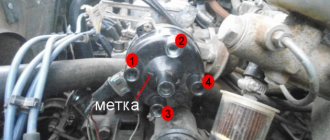Washing your favorite car is a whole philosophy.
We present a selection of products for car enthusiasts - the TOP 5 best rags for washing cars. With the help of such products, you can bring the hood of your favorite car to a shine or simply wash it - it’s a waste of money when a motorist has such chic rags in his arsenal. And these are not just words, see for yourself!
Scroll through our top five and buy excellent microfiber for car washing for mere pennies from Aliexpress.
Good news - delivery of your order will be absolutely free throughout Russia.
Good luck in your endeavors!
Suede napkin PITREW - the enemy of stains (90*55 cm)
Seller's reliability: excellent!
Delivery within Russia: free!
The PITREW suede cloth is an excellent assistant in caring for your favorite car. It is absorbent and very gentle on car paintwork. The size of the product is 90*55 cm. The cloth is almost weightless, and yet so effective in washing car bodies or car windows. Does not leave streaks or lint. Perhaps this is the best napkin for washing a car on Aliexpress. You must have it!
Review #1: Everything is fine, and wipes without streaks.
Review #2: Delivered very quickly, 12 days from the date of order. Looks just like the picture, super. Really suede. I haven't tried it yet.
Review No. 3: I bought it a year and a half ago from the same seller, and I use it often and am very pleased. So I decided to order new ones. The seller is responsible, wrote how to use. I followed his instructions and everything was great. I recommend it from the bottom of my heart.
Cloth for wet cleaning of car interior (28*28 cm)
Seller's reliability: excellent!
Delivery within Russia: free!
To wash your car you need a good cloth. Use this napkin. It's so soft and super absorbent. She can do everything - wipe the interior or wash the hood. Product size - 28*28 cm. The microfiber cloth is easy to use.
Be sure to order such an assistant on the Aliexpress website with free delivery throughout Russia.
Review #1: Microfiber as in the description, absorbs water well, fast shipping. Thanks to the seller, I will order more.
Review No. 2: The parcel arrived in 1.5 months, it was in a warehouse in China for about 2 weeks. Towels for 4, you can take them.
Review No. 3: Price - quality is completely justified.
Car washing rules. Do no harm - do not scratch, do not spill!
Signed up, drove up, washed up. Or he filled a bucket with water and washed it himself. And if you have a high-pressure apparatus... Washing a car would seem to be the simplest procedure. Not even maintenance, but something similar to washing dishes, as it is actually perceived by many. Easier than just refueling. But this is only at first glance. There is also a “damaging factor” here - chemistry. And, alas, there is no escape from the human factor.
Washing technologies
What types of sinks are there? Manual with a rag and a bucket - that’s understandable. An automatic mechanical wash is a conveyor that itself pulls the car through vertical and horizontal cylindrical brushes. Finally, the so-called contactless wash, when the body is first doused with water, shampoo is applied, then it is washed off and the car is wiped.
Mechanical washing is an expensive pleasure for its owner (it costs a lot and requires maintenance, for example, replacing brushes). In addition, it is believed that frequent use of it harms the paintwork - it is abraded by the plastic bristles of the brushes, on which particles of dirt from previous cars may remain. In addition, on some machines there is a risk of losing protruding elements such as antennas and other things. But in such complexes the influence of the human factor is excluded, and in others, washing of the bottom is provided
An option for mechanical washing is automatic contactless. The car moves through a similar portal, but there are no brushes. Instead, there are high-pressure apparatuses that wash away dirt and supply a cleaning composition to the body.
It must be said that abroad, especially in Europe, such automated systems are used everywhere. Large service centers are able to afford so-called tunnel washes, where cars undergo various procedures (rinsing, applying shampoo, washing rims, underbody, etc.), moving exactly on a conveyor belt. Another fashionable trend is self-service car washes, where the client pays for a specific procedure (rinse, shampoo, dry, wax) and does everything himself.
Tunnel or conveyor washes are a “constructor” that allows the future owner of the complex to select and assemble the necessary equipment. In Russia, these are just beginning to appear. Even “ordinary” automatic car washes - with brushes or contactless - are not available in every regional center, let alone in smaller cities
Self-service car washes are still a rare phenomenon in our country. It's a pity, because they offer a good combination of cost and the ability to independently be responsible for the quality of work
You can purchase a washing machine, or more precisely, a high-pressure apparatus (HPA). Here you need to pay attention to the power of its electric motor, which determines the output pressure and productivity (l/h). At about 100 bar, some companies limit the use of their products to gardening environments. They say that benches with tools can be washed, but a car cannot. In addition, the high pressure motor may have a water-cooled engine, which is useful for large volumes of work, or a plastic or metal pump, which affects its service life. And not have a foam kit - a reservoir for liquid or at least a nozzle for producing foam. The price of the most affordable sinks starts from 2500 rubles. These are products either of domestic brands, made in China, or products from companies from the Middle Kingdom. In general, a dubious purchase. AHP from well-known companies in this area (Patriot, Champion, Quattro, Huter) with a pressure of 100 bar or a little more can be purchased for a minimum of 4500–5000 rubles.
Huter and Karcher manufacture products in their home countries, Germany. The rest have long switched to production in China. However, the budget Huter models are also from there
Chemistry for all occasions
The choice of cleaning products is amazing. The line of every household chemicals factory that survived the collapse of the USSR includes shampoos, various stain removers, polishes, etc. The prices, even taking into account the current situation, are quite humane. Therefore, it is surprising that among car owners there are still stories circulating about how you can save a lot of money by using non-automobile - household detergents. Someone believes...
Using Fairy and other “kitchen” chemicals to wash the body is partly useless and partly dangerous. Firstly, because it only dissolves animal and vegetable fats well (in a car you have to deal with other contaminants). Secondly, the varnish may suffer from “everyday wear” and the body may bloom. White spirit and kerosene work well on bitumen stains. You just need to take into account that the first one will be extremely difficult to remove later from both hands and body panels
How to understand all the variety of means? If we talk about auto chemical manufacturers, this is difficult to do. There are a huge number of items on the market (and with regional preferences determined by the location of enterprises), which cannot be included in any examination tests. And yet, let us take the liberty of mentioning products (shampoos, organic and chemical removers, polishes) from some manufacturers: Italian MA-FRA, American 3M, Meguiar`s, Doctor Wax, Hi-Gear and ABRO, English Turtle Wax, German Liqui Moly and Sonax, as well as Russian Astrohim, Supfire and Kerry. Judging by the reviews and, alas, rare examinations, these are high-quality products. Although, as in the case of other auto fluids, the possibility of counterfeits cannot be ruled out here.
Regardless of the level of “drugs,” they must be treated with some caution. Understand that their surfactants, surfactants - in principle determining the cleaning properties - are alkaline agents that dissolve dirt and are theoretically aggressive to everything around them (hand skin, body varnish, etc.). It’s not for nothing that steam washing, which does not require any chemicals at all, is becoming fashionable abroad. We need to know that we shouldn’t rush to the car wash after every rain. Moreover, you should not soak the body in foam for more than 2-3 minutes (sometimes 5-6 minutes) - such recommendations are in the annotations for car shampoos. True, now there are products that wash away dirt in a different way.
We can name at least one similar product - from the Belgian company Chrisal. The stated principle of its operation is that it does not dissolve dirt - it separates it from the body. In addition, the product supposedly removes static electricity, due to which dirt settles on the panels much less
You can extend the washing result without these “nanotechnologies”. For the procedure, it is enough to choose not just a shampoo, but one that contains polishes or wax. To one degree or another, the positive effects of such additives are recognized by all experts. Another method is to apply separate polishing liquids to an already clean body.
Polishes or products with wax are applied to the panels with a sponge, and when dry, rubbed with a microfiber cloth. The effect here is not so much from the shine that the body acquires, but from the fact that dirt does not settle on it so actively, making several subsequent washes easier (it’s enough just to rinse the car with water). In addition, a layer of wax or Teflon contained in polishes protects the paintwork from microdamage and road reagents
Insect, tree bud and bitumen cleaners can be offered separately or as universal aerosols. In any case, they can remove the first, second, and third
Yaroslav Litvinenko
Body shop manager at the Shtabnoy service station, 10 years of experience in the specialty
— I would not say that a one-time wash can damage the paintwork. I don’t know of any examples of varnish tearing from a single use of some kind of vigorous chemicals or high pressure of a supplied water jet. Here we need to talk more about non-compliance with painting technology at the factory or poor quality work during restoration after an accident. We know of a case where the varnish came off from a new VW Touareg that had not been in an accident. The two-year-old Nissan X-Trail is blooming with rust. The Mercedes Sprinter has only 80 microns of paintwork instead of the required 180 microns. The color of the Toyota Mark X, which came from Japan, differs in shades along the bottom and top of the body. What kind of damage is there when washing? And from bodies repaired by the Chinese (or in services of a similar level) the varnish can come off in whole layers. Of course, washing will only speed up this process, but will not be the root cause of this result.
And yet, negative consequences from poor-quality washing can appear. I would not recommend using mechanical washers often or even at all. The brushes in them can damage the varnish, especially on the edges of body panels. This may not happen at once, but systematic use of such a service is guaranteed to make the coating matte. Hand washing - with a bucket and a rag - can also leave marks on the body. It is necessary to rinse the “tool of labor” thoroughly.
If you follow all the rules, there is no need to be afraid of washing. But where does this happen? In rare structures that adhere to technology and place increased demands on personnel. Well, those owners who are too scrupulous about the appearance of their own car still cannot avoid polishing the body
The best option is contactless washing. But there are nuances here too. When work is put on stream (is it any other way?), quality is not achieved. Meanwhile, there are some rules, failure to comply with which can ruin the paintwork. When wiping the body, the rag, of course, must be clean - the washer must constantly rinse it. But the main thing is the correct use of the device itself. The body must be doused with water from a distance of at least 30 cm. Usually, especially when removing dirt from arches, the nozzle is brought close. Namely, in this area, varnish and paint are highly susceptible to external influences - they are beaten off by pebbles. Water under pressure “opens” the chips, making them larger.
Finally, it gets into the cracks of the varnish, and when the car goes out into the cold, it turns into ice and tears the paintwork. After a winter full of car washes, the body may rust. In a good way, before leaving the pit there should be a frame that blows air over the car, as is done at mechanical car washes. Or the car should stay inside to dry. Or you should immediately put it in a warm garage. All this, unfortunately, is difficult to achieve.
A few words should be said about the so-called dry washing, which, if you do not want to use services at subzero temperatures, you can do it yourself. By the way, there are summer, winter and all-season compositions. The technology is simple: the liquid is sprayed onto the surface, after which it is washed with a microfiber cloth or terry towel. After complete cleaning, a number of preparations involve polishing the paintwork. In this case, the composition is applied to a rag, as in the photo on the left. The only fundamental rule is that dirt-removing wipes need to be changed (you will need several in total), otherwise dirt particles can scratch the varnish
The use of “alternative” cleaning products should also be attributed to the human factor. I myself saw how German preparations were used for washing roads, which cannot be used to wash car bodies. I won’t say anything about their cost, but they certainly cope well with bitumen – and with varnish!
To remove bitumen and similar “deposits”, not only liquid products are offered - a certain plasticine-like substance called abrasive clay. It must be handled very carefully. Otherwise... the consequences are in the photo
Roman Dmitriev
Auto electrician at the service station "ATE-Studio", experience in the specialty for more than 10 years
— After washing the engine under pressure, cars arrive or are brought to us at least once a month. In 100% of cases, candle wells are filled with water. Usually it is also in the distributor when the engine has this type of ignition. It's good if the engine doesn't start. One can hope that after blowing with compressed air everything will work without consequences. However, it happens that the unit starts up - it does not work, but it works. And a short trip is enough for something to go wrong.
A characteristic picture! At best, you need to blow out the wells. In the worst case - already change the ignition coils
Let me note that you don’t have to worry about the piston group. Water can enter the cylinders and cause water hammer only when using a zero-resistance filter, but this is a special case. I don’t remember any such collisions for it to get through the standard air path. The generator also remains operational, but the electronics may fail globally. At a minimum, these are ignition coils, various alarm relays, sirens from the same, various secrets. Diagnosis and removal of water alone will cost about two thousand. And taking into account the cost of the tow truck and the listed parts, the price of restoration work can easily exceed 10 and 20 thousand rubles. We must also remember that a jet of water under pressure can damage rubber (hoses, seals, etc.), especially old, dried out ones.
It’s worse if ECUs are located in the engine compartment, as is done, for example, in Volvo or Peugeot. Here you need to understand that the pressure of the washing machine can exceed 100 atm. Enough to “open” unsealed cases with circuit boards inside and fill the contents. Therefore, the risk of being left without a control unit is high, and this is a completely different investment. Often, related electronics, say, ABS units, are replaced. There was a case when the throttle valve unit failed on a Subaru after washing it. It turned out that there is a drainage hole in it to drain condensate. Water got inside through it. On a Toyota Tundra, she short-circuited two electric motors that pump air into the catalytic converter. And all “Europeans” have a problem with xenon. Each headlight has at least one control unit. A drop of water is enough for an expensive (from 10 thousand rubles) part to fail. Again, this is guaranteed to happen if the car has been in an accident. Let it be small, leaving the head lighting equipment seemingly intact. But there may be a crack somewhere in the plastic, and the washing machine will definitely “drive” water through it.
One example of the location of the engine control unit under the hood is Renault Logan (on the back of the shield located behind the battery). In this case, it is not covered by the housing at all - filling is as easy as shelling pears
Even the connectors need to be restored after washing - water under pressure easily gets into them, but does not pour back out. Over time, copper oxidizes and contact is lost. What to do? If you happen to wash yourself, you need to immediately, without starting the engine, blow out all the connectors and spark plug shafts with compressed air. Will this be done correctly at the car wash? The answer, I think, is obvious. Moreover, they will not be able to reach various blocks and headlights there. Therefore, there can only be one piece of advice here - under no circumstances should you wash the engine with high-pressure washers! Even water “from a hose” can get to the elements, after which they will need to be replaced with new ones. The only safe option is to use special chemicals and clean with rag brushes. An alternative, if the engine is not leaking oil, is simply purging with a compressor.
Engine cleaning fluids should be used with caution. Dissolving oil, they will also remove the paintwork under the hood. Therefore, they should only be used on specific areas of contamination! And what’s in the photo is, of course, brutal. Sometimes the engine is pressure washed even at dealerships!
Let's summarize the rules that will help you avoid damaging the body and flooding the engine:
– do not allow a large difference in the temperature of the body and water – when washing by hand, use a large amount of water to wet the dirt – use sponges, microfiber cloths (in extreme cases, terry towels), which are capable of absorbing large enough dirt particles that pose a danger to the paintwork – do not use high-pressure washers if there are chips or even microcracks in the varnish on the body – when washing without contact, do not “soak” the body for more than 2-3, maximum 5 minutes – do not bring the high pressure nozzle close to the body – make sure the napkin is clean, which wipes the body dry. Do not wipe large areas with cloth napkins without rinsing, since even after contactless washing there may remain particles of dirt that can scratch the varnish - use polishes that create a protective film and facilitate subsequent washing - do not frequently use automatic mechanical washers with brushes
Cloth for car care for mirrors and headlights XizeHOM (10 pcs, 18*15 cm)
Seller's reliability: excellent!
Delivery within Russia: free!
Grab a universal napkin for wiping mirrors and glass of not only cars, but also electronics. The set contains 10 excellent rags in individual packaging with an unusual texture. The size of the product is 18*15 cm. It turned out to be a great assistant - the car windows shine!
Perhaps this is the best napkin for glass and mirrors on Aliexpress.
Review #1: Good rags, individually packaged, fast delivery.
Review #2: Delivered in 14 days. Good napkins, bag included. Thanks to the seller!
Review No. 3: Everything is fine, good microfiber, very well packaged, each cloth is in its own package, you can store it this way to avoid dust until the day you need to unpack it.
Super sponge for washing the body VODOOL (1 piece, 17*10*7.5 cm)
Seller's reliability: excellent!
Delivery within Russia: free!
Every car enthusiast has such a sponge in their arsenal. It will help clean the car body from almost any contaminants. Just pour water and special auto chemicals into the bucket. The sponge foams perfectly and absorbs water. Product size: 17*10*7.5 cm. Fits comfortably in the hand. Be sure to order such a sponge on Aliexpress with free delivery throughout Russia.
Review #1: The sponge is not so porous, I didn’t really like it.
Review #2: Excellent sponge. Useful.
Review #3: Very good sponge.
Microfiber towel for drying cars Korper besonders (4 colors, 30*30 cm)
Seller's reliability: excellent!
Delivery within Russia: free!
After washing the car body, be sure to dry the surfaces with such a cloth. It comes in 4 colors and one size - 30*30 cm. The soft double-sided towel perfectly absorbs moisture and does not leave streaks. It's so convenient to use. Try it too!
Types of pollution
To be able to remove any layer of dirt on the car body, you need to know what type of dirt is present in a particular case. Such knowledge is necessary, first of all, in order not to damage the coating of the car when washing it. For the same purpose, they use car shampoo, which cleans it on the outside, as well as a stain remover, which removes dirt from the inside.
As for the types of contaminants covering the body, there are two types:
- organic. These are waste products of various organisms. These include fat, traces of bird and animal feces, remains of fruits and plant leaves.
- inorganic. These include dirt, dust, and small stones.
In some cases, different types of contaminants may be mixed or cover the car body in different layers. Naturally, in this case it is necessary to select individually for each type of contaminant the appropriate methods and means for their removal. If you use improvised means, you will not be able to remove dirt, since the same fat will not be lost with plain water.
We wash and protect the body
- Let's start with the materiel. First of all, static dirt accumulates on the body, which is electrified, and if you run your hand over the paintwork, you can feel that it is not smooth - there are a lot of inclusions on it. Among them are shoe dust, metal particles from brake discs that turn into red dots, bitumen, etc. These contaminants inhibit the drainage of water from the body and do not allow it to remain clean for a long time. The discs get dirty even faster because the high temperature bakes everything almost immediately.
To remove the influence of these factors on body contamination, it is necessary to clean it of bitumen, block dust and metal inclusions. Accordingly, you will need an asphalt cleaner and a metallic cleaner, also called an iron.
Many will say that bitumen can be washed with any solvent, white spirit or nefras. Theoretically, yes, but you should remember that there are pores and microcracks on the surface of the varnish. Once the solvent gets into them, it has a harmful effect on the paintwork, which will become dull after several such aggressive washes. When using specialized formulations, the harmful effects are minimal. Plus, any cleaning product intended for the average user is extremely easy to use. Roughly speaking, I sprayed it, waited, and washed it off.
But first you need to wash the body. It all starts with contactless shampoo. If you do it yourself, you will need to go to an open street car wash on a fine day or to a similar car wash, which is located indoors, where you can tinker as much as necessary. It should be remembered that self-service car washes use a highly alkaline primary shampoo with a pH of 12-13, which gives maximum effect in minimal time.
But such a shampoo minimizes all the protective properties of any quick detailers, which we will talk about later, and actively “eats” even long-term protective compounds: liquid glass, ceramics, quartz coatings. In fact, you can use such a shampoo, but there are certain regulations that must be followed: do not apply shampoo to a hot body with a temperature above 30 degrees, which is irrelevant in the autumn-winter period, do not keep it on the body for more than three minutes, rinse very well from the bottom up – any shampoo from the body is washed off with a high-pressure jet from bottom to top using horizontal movements!
If you are afraid of the “evil” shampoo from the self-wash, no one forbids you to purchase a pumping foam and low-alkaline shampoo with a pH of 8-9. For a quality wash, even foam is not necessary - emulsion on the body works better, so if you use a low-alkaline shampoo, you can even apply it with a garden sprayer. The main thing is not to pour high-alkaline shampoo into containers that are not intended for this purpose, the seals and membranes of which do not have adequate chemical resistance.
After the main dirt has been washed away, we drive the car to a place where it will not disturb other visitors to the car wash, and apply a bitumen cleaner to the body to remove the main grease films and bitumen. We wait a few minutes and wash off either with just water or with contactless shampoo, without letting it dry.
Then we apply a metal impurity cleaner. This is the most interesting and beautiful stage, since the cleaner contains an indicator, which, when reacting, acquires a purple color. So you can see where there are metal inclusions on the body that slow down the flow of water. Naturally, after waiting a few minutes, we wash it off. For better cleaning, it will not be superfluous to rub with a sponge after applying the compounds, but even after contactless use of cleaners, the body will be much cleaner than before.
We get a clean body with open micropores remaining after inclusions were removed from the paintwork. They need to be filled to make the surface as smooth as possible. To do this, you will need any quick detailer or more serious protective equipment, depending on the need and capabilities. We proceed from simplicity of work.
If after the first phase with “contactless” the car is washed with hand shampoo, then you can use liquid waxes that are not drying, but have a hydrophobic effect and an accumulation effect – popularly known as nano-waxes. They provide a good hydrophobic and antistatic agent, but there is a problem that lies in the wax itself - it is quickly washed out. From one to three washes - and there is no effect. In principle, there is nothing wrong with applying liquid waxes immediately after washing with contactless shampoo. The minimum of static contaminants that we preserve with a wax composition will simply be washed off during the next wash, and the wax will work as a damper for the remaining alkali on the body.
In terms of ease of operation, quick detailers are leaders among protective equipment. Compositions based on silicon dioxide work on the “spray and wash” principle, provide a good hydrophobe, antistatic, and stay on the body for quite a long time, about five contactless washes. At the same time, the additional shine from this composition is minimal. Wax-based “quicks” require spreading with a sponge, fiber or a special applicator; they give a good shine, but at the same time collect dust.
There are also polymer compounds that are good in winter, but require quite a long time to spread over the body. Such products contain solvents, so when applied, the body can be easily cleaned of grease films and bitumen. Polymers are very good for cars with soft varnish, for example, for “Japanese”.
It is better not to use quartz and polymer compounds after contactless washing, since the remnants of static dirt will be preserved by them for a long time.
If you don’t want to bother with all this, then many manufacturers offer polymer shampoos with preservatives for hand washing, which “add” minor risk, and then the car looks much better. The effect of such shampoos usually becomes visible after three washes.
Most of these products work well on glass as well. There are also decent anti-rain products on sale, but without good preparation of the glass they do not last long. High-quality preparation includes polishing with abrasive compounds with a felt wheel, degreasing - only after this is an anti-rain applied, which will work for a long time. A bonus of applying a good anti-rain will be the absence of ice on the windows in winter.
How can you wash a car?
There are several options for choosing products intended for washing the car body. All such products ensure safety for covering its elements during washing, and are also distinguished by better treatment with detergents. Among the most common means for cleaning and washing a car are:
In addition, various combined tools are produced, for example, a mop combined with an ice and snow scraper. Car wash brushes and other tools used for car washing must be treated with care to those parts that are cleaned or washed with their help. In addition, once the surfaces have been washed, they should not scratch, for example, in case of accidental contact with the car body.
Preparatory stage
If you want to wash your car quickly, efficiently and without streaks, you need to prepare the place and the necessary supplies in advance.
Where to wash
The right location is already half the success. Choose it so as not to splash neighboring cars and have enough space for maneuvers. Under no circumstances should you try to wash your car in the sun: under its rays, water and detergents dry quickly, leaving those notorious stains. The best place to thoroughly wash your car is a garage with good lighting or a shady area. And don’t forget: all the liquid (along with dirt and chemicals) will drain from your car onto the ground, so you shouldn’t arrange a car bath on the lawn or playground.
It is not advisable to wash your car in the sun
Detergents
The more carefully you approach the choice of washing products, the better the result will be.
- Water. Almost half of all stains appear due to poor water quality. If you do not use a filtration system and your water supply is too hard, it can leave a whitish alkaline residue on the surface of the body. Water supply systems in suburban areas very often supply water with admixtures of clay, sand and limestone, which, when dry, also leave stains. To reduce the likelihood of deposits, whenever possible, try to wash your car with filtered water.
- Hose or buckets. If you don't have a garden hose to water your car, you'll need buckets or other containers to hold water.
- Detergents. Prepare a special car shampoo. If it is concentrated, dilute it according to the directions on the package. You will also need glass cleaner. You should not use dishwashing liquid - its composition is not suitable for all paintwork.
- Auxiliary tools. To properly wash your car, prepare the following tools: a large-pored sponge, a soft brush, a silicone scraper and a cloth. Car dealerships sell special rags that are excellent at collecting moisture. Made from microfiber or soft suede. Such rags are used to thoroughly collect excess water from the surface of the body. They help prevent stains and fluff from appearing on the bodywork.
- Additional funds. Many experts advise using wax to polish the body after washing. It creates a protective film on the surface of the paintwork, removes all stains and protects the car from contamination. A body polished with wax acquires a deep, rich shade and shine.
Car shampoo
Sponges
In the case when a car owner washes a car by hand, the best option for choosing a car accessory for him will be a car washing sponge. The fact is that it does not damage the paintwork upon contact with it, as a brush does. Typically, sponges for washing cars are made of large-pored foam rubber. It perfectly absorbs moisture, as well as car shampoos, which allows you to thoroughly wash off dirt of any type and degree of complexity.
It is worth mentioning separately about such a car accessory as a melamine sponge. The fact is that it was specially designed to combat organic pollution. For example, a melamine sponge can be used to successfully remove traces of fat or waste products of birds and animals.
Secrets of washing a car
You need to wash the car after it has cooled down - this will prevent the liquid from drying out quickly. So, let's start with water procedures.
- Stage one: the car needs to be wet. This is done so that dried stains of dirt, bird droppings and other contaminants become wet and are better susceptible to the action of the detergent. Wet the entire body completely, not forgetting the lower parts of the mirrors and wheel arch liners, and also wet the wheels. If you have a hose, the whole process won't require much effort. If there is no hose, just carefully pour two or three buckets of water over the car. You can also use a large-pored sponge: after wetting it in a bucket of water, squeeze the water onto the body, trying not to touch it so as not to accidentally touch it with the sponge - this will prevent small scratches from dried dirt from appearing on it.
- Stage two: apply detergent. To do this, you can use a spray bottle or the same sponge that you used to wet the body. After applying the shampoo, you can wait a couple of minutes - it will properly soften the dirt. Then we start washing the car.
- Stage three: washing. Using a soft sponge, carefully wash away dirt from the body from top to bottom. Try not to press too hard on the sponge and make sure that there are no large grains of sand on it that could scratch the coating. You can wash wheels and rims with a brush. Don't overlook doorways.
- Stage four: rinsing. Rinse off any remaining detergent from the body using a hose or spray the car with a bucket. Check the soft washcloth for debris and go over the body again, soaking it in clean water.
- Stage five: drying. Here you will need a silicone scraper and a special microfiber or soft suede cloth. Use a scraper to remove excess water from the surface of the body, and then go over it with a cloth, collecting moisture and periodically squeezing it out. This way you can avoid the appearance of plaque and stains.
- Stage six: glass washing. You can wash mirrors and glass using glass cleaning spray and a soft, dry cloth. Spray the product carefully so that excess does not get on the freshly washed body.
- Stage seven, final. A cloth made of suede or microfiber effectively removes all moisture without leaving stains, however, many car owners prefer to use car polish to add shine to the coating and provide additional protection. Apply polish according to the instructions on the package.
A special rag will help you wipe your car without stains.
We hope that these recommendations will help you quickly learn how to wash your car without streaks on the body. Good luck!
Subscribe to our channel on Telegram. Latest and current news from the automotive world!
Car wash brushes
In the same case, when the issue of saving car shampoos is important for the car owner, or in the case when there is persistent dirt on the hood of the car, he should wash the car with a brush. With it, provided there are hard bristles, you can wash even wheels and rims that bear traces of asphalt and tar.
If it is necessary to wash and clean the interior, a rubber brush is used, but it should not be used to wash body parts. The fact is that such a brush can scratch the car’s paintwork with grains of sand or dirt adhering to it. Here it is better to use a different type of brush or sponge.
To wash the body, it is best to use a brush with a telescopic handle, which allows you to reach parts that are located in the most difficult to reach places. Such a water supply device can often be found in car washes. In any case, you need to take a soft, fluffy brush, and not a hard one with a solid structure. It is impossible to damage even a thin layer of paint or varnish with such a product.
Brushes with a water supply can not only mechanically remove dirt, but also wash it away and soften it before removal. The pressure can be adjusted as needed. As a result, you can almost perfectly wash not only smooth, but also corrugated surfaces.
Rag, brush or sponge?
If you choose a sponge, then it should be specialized for use on cars. These are usually sold in markets or parts stores and are made of foam rubber with large grains and holes. A characteristic difference from a regular dishwasher or bath sponge, for example, is that large pores are able to absorb sand and dirt, keeping them from rubbing over the surface of the car’s paintwork. This prevents minor scratches from occurring.
It is not recommended to use a brush, even the softest one, to wash the body (especially of new cars). It is best suited for washing wheels or protecting them where there is no specific varnish, like in auto body parts. But a combined sponge-brush made on a microfiber basis is quite suitable for the body, especially in combination with a good technical shampoo.
As for the rag, some professional washers say: no rag is suitable for washing more or less quality, since any fabric is not able to absorb large volumes of water (like sponges or fibers)! Perhaps their opinion is worth listening to. But here are the very extreme options that can still be used with some difficulty: soft rags made of natural cotton with small additions of synthetics, old terry towels. But still, in order not to cause harm, it is better to avoid it.
But for final care after washing, a rag is a nice thing. Microfiber or suede, it will collect residual drops of water from the surface of the body, preventing the appearance of unsightly stains and streaks.
Useful tips
Automakers, as well as companies specializing in providing car wash services, have developed a list of tips that allow you to wash your car quickly and efficiently. So, if a sponge is used for washing, it must be rinsed frequently, since a large amount of water allows abrasive materials to be washed out of it. As a result, the enamel that tears the car body will not be damaged.
Another important tip is to never use improvised products to wash your car. Use only high-quality materials and specialized shampoos. Handy rags, washing powder and dishwashing liquid can damage the paint and also leave difficult-to-remove stains on the enamel.
A car washing brush cannot be used to remove snow from the surface of the glass, as well as the hood or body. It is imperative to use a special brush. It has specially split ends that will allow you to sweep away snow without scratching your car. Glass is cleared of ice and snow using scrapers with rubber or foam padding.
Separately, it is worth noting the need to wash the wheels while washing the car. A lot of dirt accumulates on their inside, which becomes compacted over time and upsets the balance with its weight. In general, the washing procedure must be carried out once a week in order for the car to be perfectly clean.
Artificial options
It should be noted that now there are many types of them, from very cheap to really expensive and high quality. Personally, I have two such rags, one was bought by me, the second was given to me as a birthday present, because I myself would not have bought it (it is very expensive, about 1000 rubles).
1) Cheap rag. Also sold in a tube, it is advisable to keep it moist. Consists of rubberized - foam material.
They remove moisture well, but with stains, not everything is so perfect. If you get used to it, there may be no streaks left, but it is not always possible to remove it the first time. Quite “tenacious”; if it dries, it becomes hard; as soon as it gets wet, it returns to its working condition. A small minus is that it is not resistant to mechanical damage, even minimal damage; as soon as you “touch” it, the foam layer begins to come off, and if you rub the surface too hard, it can leave small hairs—fibers.
It is not expensive (the cheapest of all, from 100 to 200 rubles), sold in yellow tubes in almost all auto stores, as well as in any supermarket.
2) Perforated cloth. Almost the same as the first option, however, it has small perforations (holes on the surface). It's even more foamy. To be honest, drying it out just kills it (it crumbles), meaning it always needs to be kept wet. Therefore, you need to think about your purchase.
3) Faux suede. This is the best option for a car; they are made of 100% polyvinyl.
when drying, it does not deform - it does not dry out, just wet it and it is ready for use again. It wipes better than anyone else; stains really don’t remain on the car body or windows.
One disadvantage, which I already wrote about, is the high price of this device. Personally, I would think several times before buying the option for 1000 rubles; you can buy five regular ones.
Of course, there are also synthetic fabric options, which also cost a penny, but they don’t wipe the body as effectively, and stains are still noticeable. Therefore, I will not advise them to you.
Now let’s take a look at a short video comparing two of my car rags.
That's all, buy it correctly, then they will serve you for a very long time.
Read our AUTOBLOG, subscribe to our groups.
(15 votes, average: 4.33 out of 5)
Similar news
Neoline EVO Z1. A detailed review of the DVR, as well as my o.
Trendvision Split. Review of an interesting DVR
Inspector Typhoon, mirror-video recorder with GPS function. Full
Every car needs care and attention. This also includes body washing and polishing. This is necessary not only to create an external gloss, but also to extend the life of the paintwork. Constantly using the services of professional car washes is ruinous for the family budget, especially if you have the opportunity to wash your car yourself.
This is where the first question comes in. How to achieve the same result that professionals manage to achieve? You have to spend a lot of time to remove stains, drips and other unpleasant phenomena from the surface of the car. Professionals have several secrets that allow them to achieve high results in a short time. One of these secrets is choosing the right cloth for your car. Moreover, for each of the processes of creating an external gloss, a special rag is required.
conclusions
Washing a car is a mandatory procedure included in the list of maintenance work. You can wash your car using several devices, but it is best to use sponges, and to combat stubborn stains, brushes with water supply. In this case, you will remove even the most stubborn dirt from the surface of the vehicle without damaging the paintwork.
Every car needs care and attention. This also includes body washing and polishing. This is necessary not only to create an external gloss, but also to extend the life of the paintwork. Constantly using the services of professional car washes is ruinous for the family budget, especially if you have the opportunity to wash your car yourself.
This is where the first question comes in. How to achieve the same result that professionals manage to achieve? You have to spend a lot of time to remove stains, drips and other unpleasant phenomena from the surface of the car. Professionals have several secrets that allow them to achieve high results in a short time. One of these secrets is choosing the right cloth for your car. Moreover, for each of the processes of creating an external gloss, a special rag is required.
Using dish soap
There is another option for washing your car - the old fashioned way, by hand, at the dacha. In the summer, some people save on “water procedures” by avoiding car washes and doing everything on their own outside the city. Here, as you understand, the risk of spoiling the paintwork is also quite large, especially if you don’t have your own Karcher, and the set of tools comes down to a bucket and a rag.
The recommendations are simple, like the old joke about delicious tea - do not hesitate to use more water to wash away dirt
There are a lot of detergents on the market and in this foaming ocean it is worth paying attention to products containing polishes or wax. Their advantage is that after use the dirt sticks to the body somewhat less, and subsequent washes, according to experts, are a little easier
And God forbid you wash your car yourself with some dishwashing detergent like Fairy - they contain alkalis, acids and abrasives that can harm the paintwork. Of course, you can find polar opinions of users on the Internet. Some argue that there is no harm, and the savings are obvious. Others give their own arguments, saying that the varnish is destroyed and paint defects appear. Be that as it may, we strongly do not recommend that you find out the truth through experience.
In general, in washing a car, as in brushing teeth, feeding aquarium fish and providing first aid, the main rule applies - do no harm. Or maybe your tank is not afraid of dirt at all?
There are a lot of tips and reviews on the Internet on how to properly dry a car without damaging the paintwork. For those who are concerned about the topic of proper car washing, I think they have studied everything thoroughly and know the best way to wipe their car after washing! or is it better not to wipe it at all, of course, but to use a turbo dryer
Sponges, napkins and rags for car washing
There is still debate as to what is better to use for washing a car: rags or sponges, or maybe it’s even worth choosing napkins. Experts' opinions were divided. Some of them prefer sponges, others prefer rags. One thing is for sure: you need to buy these consumables only in specialized automotive stores.
- Sponges are great for washing vehicles. Durable foam rubber is used for their manufacture; it has large pores, demonstrates high absorbency and copes well with dirt. Due to the large pores, the sponge retains small abrasive debris (dust, sand), which does not scratch the surface.
- The cloth for washing the car must be special. Ordinary rags leave micro-scratches on the body that are initially invisible, but in the future they cause a lot of trouble. In addition, washing rags will not allow you to get a perfect, streak-free surface. Rags have a number of negative aspects that appear when compared with sponges:
- low ability to absorb water;
- ability to retain abrasives on the surface.
As you can see for yourself, rags are not the best option, especially if you have the opportunity to purchase a sponge. Motorists are offered another option with which to wash their car - napkins.
- Napkins are an expensive option, which is chosen by especially responsible and caring drivers. A suede car wash cloth works best. Other materials are not as effective.
Natural options
There is no secret here, there are only two of them:
1) These are fabric options consisting of cotton with the addition of wool. They are very rare, but they do occur, I have seen them myself. The disadvantages include poor cleaning of the surface until a dry rag really leaves no streaks. But as soon as it gains moisture, they appear on the entire surface. The only plus is that these options are the cheapest.
2) Made from genuine suede (suede leather) . Such options are durable, wipe the body quite well, because they absorb excess moisture. However, such rags have a big disadvantage: they dry out very much, after which they can crack and collapse, and therefore it is better to always keep them damp. In a special tube.
To be honest, the guys, “natural” rags, are losing to their “artificial” counterparts. They are no longer so effective in the “field” of wiping, and therefore I advise you to look at the second type.
What is the best way to wipe a car after washing?
The car must be dried after washing. If you do not do this, the entire surface will be covered with stains, water marks and stains. For these purposes, you cannot use materials that were used for washing. You must have consumables for wiping your car.
A rag for wiping a car after washing is available in a huge assortment. This amount makes your eyes wide open, so you need to go to the store prepared. This entire number of rags is divided into two groups, depending on the material from which they are made.
- Natural rags can be fabric or suede. For the first, cotton and wool are used. Finding them can be difficult, but, as they say, if you have the desire. Such rags only remove stains well when dry. When they are saturated with water, the effect is significantly reduced. The cost is low, which pleases and seduces many car owners. Natural suede is expensive and not everyone can afford it. But such rags last for a long time, they are very effective in combating water on the body. The suede rag should not dry out, as it may crack, which will negatively affect its functionality. For storage you need to use a tube, and the rag itself should always be slightly damp.
- Artificial materials are presented in a huge range. You can choose an affordable option or stay with an expensive one. Their durability and properties will be appropriate. We have identified several main options that will help you navigate this assortment:
- Cheap consumables are made from rubberized, foam material. They absorb moisture well, but you have to work hard to get rid of stains. Few people manage to achieve the desired result the first time. But if you gain experience and dexterity, then even with such a budget option you can achieve the desired result in a short time.
- Perforated is characterized by greater foaming. Does not tolerate complete drying, much less drying out. As a result, it crumbles and becomes completely unusable.
- Artificial suede is the best option offered to the modern motorist. To create such instruments, 100% polyvinyl is used. Such rags can be stored dry, while their properties remain unchanged. It copes better with remaining water than other options, and leaves no streaks on either metal or glass. Such rags cost a lot, this is their main drawback. Few people can afford to spend more than a thousand rubles on it. But she's definitely worth it.
Each driver decides for himself how best to wipe the car after washing.
High-quality wipes and cloths for car polishing
An equally important procedure is polishing. A large number of special products are produced for this purpose. We have already talked about choosing a polish in one of the topics. All that remains is to figure out which rag is best to polish the car. There are a number of requirements for such napkins:
- thin fibers cope better with the task;
- the absence of lint is a prerequisite, since the separated pieces of thread will mix with the polishing material and reduce the efficiency of work;
- lint can turn into an abrasive that will damage the protective layer of the car.
In appearance, polishing cloths are not much different from each other, but there are still differences between them. They consist of the material that is used to create rags and napkins.
- Microfiber is great for polishing. Such napkins perfectly absorb moisture, effectively cope with stains and do not leave lint behind. Polyester and polyamide are used to produce microfiber car polishing cloth.
- Cotton and wool (flannel, flannel) are only suitable for applying polish and pre-rubbing it.
- Felt is great for polishing the body. It can replace more expensive napkins.
- Rags in the form of a mitten are more expensive, but they are more convenient to work with. It takes less time to polish with such a tool. They are created from different materials: microfiber, polyester, even faux fur.
We told you which rag is better to polish a car to achieve a good effect, so we hope there will be no problems with this. The main thing is that you should not use rags and rags, the material of which is completely unsuitable for these purposes.
Take proper care of your car, then its appearance will always please you.
